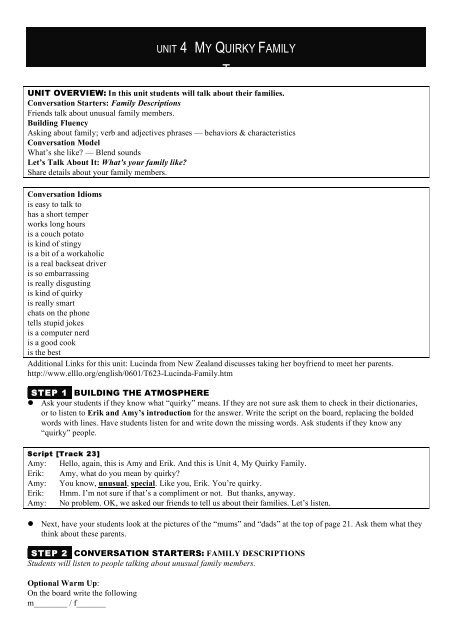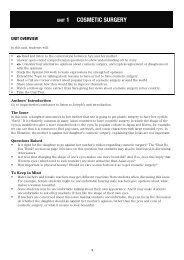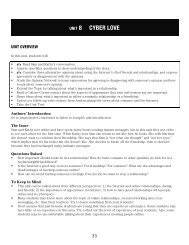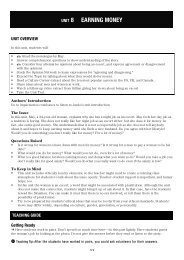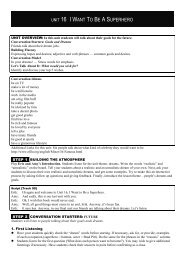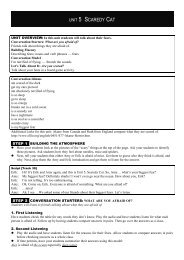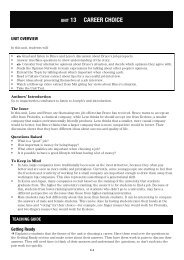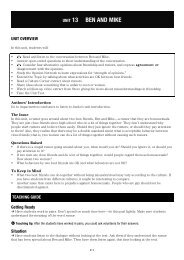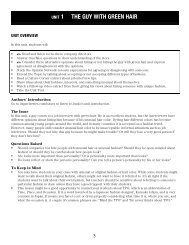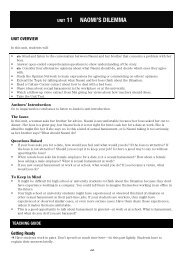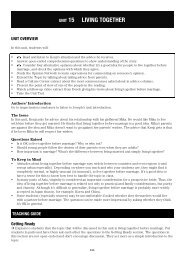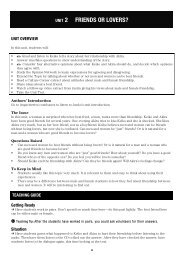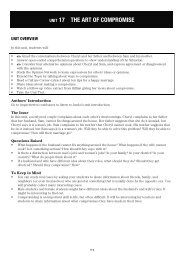UNIT 4 MY QUIRKY FAMILY - Impact Series
UNIT 4 MY QUIRKY FAMILY - Impact Series
UNIT 4 MY QUIRKY FAMILY - Impact Series
Create successful ePaper yourself
Turn your PDF publications into a flip-book with our unique Google optimized e-Paper software.
<strong>UNIT</strong> 4 <strong>MY</strong> <strong>QUIRKY</strong> <strong>FAMILY</strong><br />
<strong>UNIT</strong> OVERVIEW: In this unit students will talk about their families.<br />
Conversation Starters: Family Descriptions<br />
Friends talk about unusual family members.<br />
Building Fluency<br />
Asking about family; verb and adjectives phrases — behaviors & characteristics<br />
Conversation Model<br />
What’s she like? — Blend sounds<br />
Let’s Talk About It: What’s your family like?<br />
Share details about your family members.<br />
Conversation Idioms<br />
is easy to talk to<br />
has a short temper<br />
works long hours<br />
is a couch potato<br />
is kind of stingy<br />
is a bit of a workaholic<br />
is a real backseat driver<br />
is so embarrassing<br />
is really disgusting<br />
is kind of quirky<br />
is really smart<br />
chats on the phone<br />
tells stupid jokes<br />
is a computer nerd<br />
is a good cook<br />
is the best<br />
Additional Links for this unit: Lucinda from New Zealand discusses taking her boyfriend to meet her parents.<br />
http://www.elllo.org/english/0601/T623-Lucinda-Family.htm<br />
T<br />
STEP 1 BUILDING THE ATMOSPHERE<br />
Ask your students if they know what “quirky” means. If they are not sure ask them to check in their dictionaries,<br />
or to listen to Erik and Amy’s introduction for the answer. Write the script on the board, replacing the bolded<br />
words with lines. Have students listen for and write down the missing words. Ask students if they know any<br />
“quirky” people.<br />
Script [Track 23]<br />
Amy: Hello, again, this is Amy and Erik. And this is Unit 4, My Quirky Family.<br />
Erik: Amy, what do you mean by quirky?<br />
Amy: You know, unusual, special. Like you, Erik. You’re quirky.<br />
Erik: Hmm. I’m not sure if that’s a compliment or not. But thanks, anyway.<br />
Amy: No problem. OK, we asked our friends to tell us about their families. Let’s listen.<br />
Next, have your students look at the pictures of the “mums” and “dads” at the top of page 21. Ask them what they<br />
think about these parents.<br />
STEP 2 CONVERSATION STARTERS: <strong>FAMILY</strong> DESCRIPTIONS<br />
Students will listen to people talking about unusual family members.<br />
Optional Warm Up:<br />
On the board write the following<br />
m________ / f_______
________ / s________<br />
a________ / u________<br />
s________ / d________<br />
h________ / w________<br />
g________ / g________<br />
Ask your students what this unit is about (they should remember from Erik and Amy’s introduction). Challenge the<br />
class to fill in the word puzzle by completing the word pairs (one male, one female) for family members with similar<br />
status on a family tree. Do the first one as a class and then have students finish the task in pairs or individually.<br />
Finally, go over as a class.<br />
Answer Key<br />
mother / father<br />
brother / sister<br />
aunt / uncle<br />
son / daughter<br />
husband / wife<br />
grandfather / grandmother<br />
1. First Listening<br />
Have students check the table for any words they don’t know. Then ask students to listen for which family member<br />
each person is talking about. Play the audio as many times as needed and then have students compare answers in pairs.<br />
2. Second Listening<br />
Have the students listen again and complete the sentences in the right column. Encourage students to share other<br />
information they heard.<br />
If you like, have your students summarize their answers using this model:<br />
Inna is annoyed with her mother because she tells her dad what to do in the car.<br />
Answer Key<br />
First Listening:<br />
1. b 2. a 3. c 4. b 5. a<br />
Second Listening:<br />
1. b 2. b 3. a 4. b 5. a<br />
VOCAB TROUBLESHOOTING:<br />
Drive = drive a car<br />
Make jokes = to tell a funny story in order to make people laugh<br />
Clean up = make clean<br />
In public = not in your own home, where many people are<br />
Show affection = to show that you love someone by kissing or hugging them<br />
BONUS:<br />
Have students answer the questions. To facilitate speaking, you can add simple questions to serve as prompts,<br />
especially for question 2. These can be written on the board as follows:<br />
Is anyone in your family…<br />
…like Inna’s mom? (backseat driver)<br />
…like Soon’s dad? (workaholic)<br />
…like TJ’s grandmother? (dresses inappropriately)<br />
…like Scott’s sister? (different diet)<br />
…like Blair’s mother and father? (show affection in public)<br />
Script: [Tracks 24-28]<br />
1. Inna<br />
Everyone in my family is really into cars: me, my older brother, my mom and dad. Which is cool, but it also causes a<br />
lot of problems. You see, my mom is a real backseat driver. She always tries to tell my dad how to drive, which<br />
always leads to fights. When we were kids, we didn’t go on vacation for eight years because of that!<br />
2. Soon<br />
In my family there is me and my mom — oh, and my dad too. I always forget to include him. Actually, my mom and I
always joke that Dad doesn’t live with us, because he spends so much time at work that he practically lives there. Of<br />
course we love Dad, he’s just a bit of a workaholic.<br />
3. TJ<br />
I live together with my grandma, just the two of us. But actually, I’m thinking of moving out. You see, I’m having a<br />
bit of a problem with her. I mean, she’s 70 years old, but she still tries to look young, wearing these short skirts and<br />
lots of makeup. I love my grandma, really I do. But it’s got to stop. It’s too embarrassing.<br />
4. Scott<br />
Everyone in my family is a vegetarian: me, my mom and my brother. Everyone, that is, except my younger sister, who<br />
loves meat. She always invites her friends over for barbecues, which just makes the whole house smell like… meat,<br />
which is really disgusting to us. She just doesn’t respect our beliefs.<br />
5. Blaire<br />
I really love my parents. I think they’re the best. But I think they love each other a bit too much. The thing is, they<br />
always kiss each other. I mean, I don’t like it when they kiss at home, but I can’t do anything about it. But they kiss<br />
when we all go out for dinner or to the movies, too. It’s so embarrassing. I wish they’d stop.<br />
STEP 3 BUILDING FLUENCY: ASKING ABOUT <strong>FAMILY</strong><br />
Students will practice asking about family members.<br />
1. Expressions<br />
Books closed. Dictate the five questions (on the left side of the box) to the students. Only dictate the questions, not<br />
the responses. Say each question naturally. Encourage the students to ASK for repetition by only saying the phrase<br />
once. Next, have students compare answers.<br />
Then elicit the questions from the whole class and write them on the board. Model the pronunciation of each and<br />
have students chorally repeat. This is actually very important. If students feel they can say the phrases naturally<br />
they will be much more motivated to discuss families later in the Let’s Practice section.<br />
In pairs, have students think of one sample response for each question. (Note that their books are still closed).<br />
Next, have the students switch pairs and compare their potential responses with their new partner.<br />
Optional step: If you want to ensure that your students understand what each “question” is really asking<br />
about/for, ask them these confirmation questions:<br />
a) Which question is asking about someone’s job? (3)<br />
b) Which question is asking about your relationship? (5)<br />
c) Which is asking for some information? (2)<br />
d) Which is asking about personality? (1)<br />
e) Which is asking about hobbies? (4)<br />
Finally, have students open their books and match the questions and the responses. This should only take a few<br />
minutes to do. Explain that in conversational English “Well…” is often said before responding to questions.<br />
Answer Key<br />
1. c 2. d 3. e 4. a 5. b<br />
2. Vocabulary<br />
In pairs have your students match the phrases with the best pictures. Then go over as a class. You can reinforce the<br />
vocabulary by having students cover the words above the images with a piece of paper or a card. Then have students<br />
quiz each other using only the images as prompts:<br />
A: What is image “h”?<br />
B: "Works long hours." What is image “f”?<br />
A: "Has a short temper."<br />
Answer Key<br />
1. g 2. d 3. f 4. h 5. b 6. a 7. e 8. c<br />
VOCAB TROUBLESHOOTING:<br />
has a short temper = gets mad easily<br />
is a couch potato = is always watching TV<br />
is kind of stingy = doesn’t like to spend money, especially on other people<br />
HOW THE GRAMMAR WORKS:<br />
Before moving on to Let’s Practice, go over the uses of “like” as a class. Check understanding by asking the three
questions to a handful of students.<br />
3. Let’s Practice<br />
Have your students use the questions in step (1) and the phrases in step (2) to talk about their family members.<br />
Encourage them to use “well” before answering the questions. Also encourage them to add additional information and<br />
to ask follow up questions as appropriate.<br />
STEP 4 CONVERSATION MODEL: WHAT’S SHE LIKE?<br />
Students will practice blending sounds.<br />
Optional Warm Up:<br />
Write the following questions on the board.<br />
1) How many people are in the woman’s family?<br />
2) Who does she talk about?<br />
3) What does she say about this person?<br />
Books closed. Direct the students to the questions on the board. Next, have the students listen to the audio and try to<br />
answer the questions above. After listening as needed, students compare answers in pairs and then as a class.<br />
1. Situation<br />
Books open. Have your students check the conversation for unknown words, and explain any difficult phrases.<br />
Next, play the conversation model [Track 29].<br />
HOW THE PRONUNCIATION WORKS: BLEND SOUNDS<br />
Next, discuss how “r” is pronounced in the conversation. The “r” sound in “are” is often unpronounced [a:]. The “r”<br />
sound in “there” is also often unpronounced [thea]. However, when “r” is followed by a voiced vowel sound we often<br />
pronounce the “r” sound, and this “r” sound joins with the following vowel sound. For example “are in” sounds like “a<br />
rin” and “there are” sounds like “the ra”. Practice this a few times as a class.<br />
As a class do a choral practice of this conversation, focusing particularly on the “r” sound. Say each line or chunk,<br />
and have your students repeat.<br />
EXTRA PRONUNCIATION POINTS: REDUCE AND BLEND SOUNDS<br />
There are six of us all together = the ra(r) siksovus all together<br />
But we usually get along really well = bu(t) we usually getalong really well<br />
2. Substitution<br />
Have students work individually to connect the information in the columns to make a coherent conversation. Then,<br />
have students compare answers in pairs.<br />
Answer Key<br />
a) 3 – mom and grandfather – grandpa – He’s not so easy to talk to<br />
b) 5 – mom, my dad, my older sister and my younger brother – sister – She has a really short temper<br />
c) 4 – mom, my dad and my older brother – dad – He works long hours<br />
(Note: It is possible for “He works long hours” and “He’s not so easy to talk to” to go with either grandpa or dad.)<br />
3. Practice<br />
Have students use the substitution words to practice the conversation. Remind them to take particular care with<br />
the “r” sound. Have early finishers create their own conversations.<br />
Choose a pair to demonstrate the conversation. Comment on their pronunciation of the “r” sound and offer<br />
pronunciation and intonation advice as necessary.<br />
STEP 5 LET’S TALK ABOUT IT: WHAT IS YOUR <strong>FAMILY</strong> LIKE?<br />
Students will share details about their family members.<br />
1. Get Ready<br />
Have students check the boxes for any phrases that they don’t know. Give students time to think of family members<br />
who match the descriptions in the boxes. Then they should write a family member’s name or their relationship in at<br />
least eight of the boxes. If possible, they should try to think of eight different family members. As preparation for the
discussion, encourage students to briefly think about their reasons and examples.<br />
VOCAB TROUBLESHOOTING:<br />
Chats on the phone a lot = always talks on the telephone<br />
Has a cool job = has a really interesting job<br />
Tells stupid jokes = tells jokes that aren’t funny<br />
Is into cars = likes cars / is interested in cars<br />
Is a computer nerd = really likes computers (and is a bit uncool)<br />
Is embarrassing = makes you feel ashamed<br />
2. Let’s Talk<br />
Put students into small groups or pairs. Each group member should take turns in asking questions/initiating<br />
conversations, but all group members should answer each question.<br />
Encourage the students to expand on their answers and to ask follow-up questions to each other. Write a few<br />
sample sentences and questions on the board to facilitate speaking:<br />
Who in your family… (+ verbs)<br />
Does anyone in your family… (+ verbs)<br />
Is anyone in your family… (+ adjectives/nouns)<br />
Nobody in my family has a cool job.<br />
There is nobody in my family who works overseas.<br />
No one in my family…<br />
How (What) about you? / How (What) about your family?<br />
3. Follow Up<br />
Have your students briefly compare their answers with another group or pair. Get them to discuss if their family<br />
members are similar or different. To wrap up the activity ask a few students about their family members and comment<br />
on how different or similar our families can be.<br />
BONUS: Speaking Activity<br />
For these two questions it is easy to have a simple debate. If possible, put students in groups of three. Then have two<br />
students take the side of one of the arguments (only child vs siblings or oldest vs youngest). Give the debating<br />
students two or three minutes to discuss their points with each other and then when the time is up, the third students in<br />
their group must decide who was the winner and why. Have students alternate roles and be sure that everyone in the<br />
group gets a chance to be one of the debaters.<br />
BONUS ACTIVITIES: Family History<br />
Have students give a brief presentation about their family using only a few photographs as prompts.<br />
Have students write an essay about their families and ask them to attach a photograph(s).<br />
STEP 6 LANGUAGE AWARENESS<br />
Assign the language awareness activity on page 84 for homework. If necessary, do the first one or two questions<br />
together as a class. Leave 5 or 10 minutes at the beginning of the next class to go through the answers.<br />
Answer Key<br />
1. really into cars<br />
2. (which always) leads to (fights)<br />
3. kids<br />
4. mum and dad having fights (because mum tried to tell dad how to drive)<br />
5. If you use dad to replace his name, capitalize it. (“Of course we love Dad.”) If you use it with a possessive<br />
adjective, don’t capitalize it. (“Of course we love our dad.”)<br />
6. (a) workaholic<br />
7. NO (we use “a bit” with adjectives and “a bit of” with nouns)<br />
8. grandma trying to look young<br />
9. invite over (she invites her friends over)<br />
10. disgusting<br />
11. (I can’t) do anything about (it)<br />
12. (I) wish they’d stop
STEP 7 ERIK’S VOCABULARY TIP<br />
This study tip is about how we refer to our family members in everyday conversations. Most students learn the terms<br />
mother, father, etc. However, when they use these in everyday conversations and emails it can sound too formal and<br />
unnatural. Introduce them to the casual terms for referring to family members.<br />
CULTURAL TIP:<br />
In some languages, such as Japanese, speakers refer to their siblings as being their older or younger brothers and<br />
sisters, rather than as their brother or sister. While this also occurs in English, it’s often more common — and more<br />
natural — to just say brother or sister.<br />
STEP 8 <strong>UNIT</strong> TEST<br />
Make copies of the Unit Test for each student. Start by playing the audio for the Listening section (download Track 4<br />
from http://www.elttestcenter.com). Decide whether you give them one or two listenings. Then, allow the students<br />
about 5-10 minutes to complete the rest of the test. Correct the test in class, and record the score.<br />
AUDIO SCRIPT:<br />
F: Do you ever have fights over the remote control in your house?<br />
M: We used to all the time. Like, my dad always switched from channel to channel when my mom and I were<br />
watching our favorite TV drama. It drove us mad because we could never see the end of the show.<br />
F: So, how did you make him stop?<br />
M: We threw away the remote control!<br />
ANSWER KEY:<br />
Part A.<br />
1. d<br />
2. a<br />
Part B.<br />
3. is your sister<br />
4. get along well with<br />
5. What does<br />
6. Tell me about<br />
Part C.<br />
7. jokes<br />
8. temper<br />
9. overseas<br />
10. good English
<strong>UNIT</strong> 5 SCAREDY CAT<br />
<strong>UNIT</strong> OVERVIEW: In this unit students will talk about their fears.<br />
Conversation Starters: What are you afraid of?<br />
Friends talk about things they are afraid of.<br />
Building Fluency<br />
Describing fears; nouns and verb phrases — fears<br />
Conversation Model<br />
I’m terrified of flying. — Stretch the sounds<br />
Let’s Talk About It: Are you scared?<br />
Talk about your fears in a board game activity.<br />
Conversation Idioms<br />
am scared of the dark<br />
get my ears pierced<br />
am absolutely terrified of flying<br />
is so deep<br />
go to sleep<br />
is so creepy<br />
breaks out in a cold sweat<br />
is a scaredy cat<br />
has a nightmare<br />
is as cool as a cucumber<br />
sounds crazy<br />
is my biggest fear<br />
Additional Links for this unit: Akane from Canada and Ruth from England compare what they are scared of.<br />
http://www.elllo.org/english/0451/477-Akane-Horror.htm<br />
STEP 1 BUILDING THE ATMOSPHERE<br />
Have your students look at the pictures of the “scary” things at the top of the page. Ask your students to identify<br />
these pictures. Ask students how they feel about needles, mice and spiders.<br />
Next, tell your students that either Amy or Erik is afraid of mice. Get them to guess who they think is afraid, and<br />
why. Next, play them the Amy and Erik introduction and get them to listen for the answer.<br />
Script [Track 30]<br />
Erik: Hi! It’s Erik and Amy again, and this is Unit 5, Scaredy Cat. So, Amy… what’s your biggest fear?<br />
Amy: My biggest fear? Definitely sharks! I won’t even go near the ocean. How about you, Erik?<br />
Erik: I’m not telling. It’s too embarrassing.<br />
Amy: Oh. Come on, Erik. Everyone is afraid of something. What are you afraid of?<br />
Erik: …mice!<br />
Amy: Ah, I see… We asked some of our friends about their biggest fears. Let’s listen.<br />
STEP 2 CONVERSATION STARTERS: WHAT ARE YOU AFRAID OF?<br />
Students will listen to friends talking about what they are afraid of.<br />
1. First Listening<br />
Have students check the table for any words they don’t know. Play the audio and have students listen for what each<br />
person is afraid of. Follow up by having students compare answers in pairs. Then go over the answers as a class.<br />
2. Second Listening<br />
Play the audio and have students listen for the reasons for their fears. Allow students to compare answers in pairs<br />
before checking answers as a whole class.<br />
If time permits, have your students summarize their answers using this model:<br />
Alex is afraid of the ocean especially deep water.


